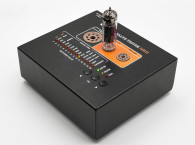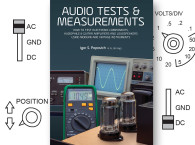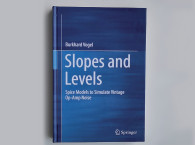 I ordered this book, Getting the Most Out of Vaccum Tubes, from KCK Media Corp. while I was researching tube service life issues. It is an unusual book, not discussing what you can do with tubes, how to use them in circuits, operating parameter calculations, or that sort of thing. Instead, it is solely devoted to factors that decrease useful service life or cause catastrophic failures. Its subtitle, aptly, is “Types and Causes of Tube Failures, What to Expect from Tubes, Testing Methods, and All about Tube Maintenance Programs.”
I ordered this book, Getting the Most Out of Vaccum Tubes, from KCK Media Corp. while I was researching tube service life issues. It is an unusual book, not discussing what you can do with tubes, how to use them in circuits, operating parameter calculations, or that sort of thing. Instead, it is solely devoted to factors that decrease useful service life or cause catastrophic failures. Its subtitle, aptly, is “Types and Causes of Tube Failures, What to Expect from Tubes, Testing Methods, and All about Tube Maintenance Programs.”Yes, and you’d be surprised how the wrong type (or too much) maintenance activity on tube equipment can actually damage individual tubes or decrease their service life. One example: I know of audiophiles who regularly “re-seat” their tubes in an attempt to make sure the pin contacts are OK. Robert B. Tomer, the book’s author, advises against that: If it works, leave it alone.
Re-seating will put stress on the pin-glass interface, leading to micro-cracks and air leaks, hastening tube demise. A corollary: When inserting tubes for the first time, use a pin straightener first, rather than forcing the pins to straighten themselves by wriggling them into the socket.
Tomer talks about different types of failures. The most obvious is of course catastrophic failure, the tube just stops working. But degenerative failures, where emission slowly decreases, leakage increases and the cathode gets depleted are just as serious although often not identified until in an advanced state. Then there are subjective failures — the tube happily continues to work but develops hum, noise, or microphonics. This book is about how to avoid those failures or at least how to postpone their occurrence.
A chapter I found particularly interesting is about the spread in characteristics of real tubes vs. the datasheet values. It is very insightful, to read how the datasheet values are set, and what sort of variation to expect from the tubes you just bought. There also is a chapter on tube testers, showing that there are many different types and that the measurements are not always correct or the same between testers. He tested 100 tubes with several commercial tube testers of the day. Tested in the lab, 95% of the tubes were better than the datasheet indicated, but one Tube Tester reported 50% of the lot as below the datasheet values!
One factor you wouldn’t expected to be related to tube life: fixed- vs. auto-bias. Fixed bias has a greater chance of failure because if anything in the circuit goes wrong, there is no degenerative mechanism like a cathode resistor to counteract possible runaway current. Do you take that into account in your design? Being aware of it lets you make the trade-off. Finally, two chapters discuss “Predicting Tube Performance” and “Methods for Lengthening Tube Life.”
 So there you have it. An unusual book, but in an era where much-sought-after tubes can cost several hundred dollars each, it is a book that should be on the shelf of anyone who is serious about tube equipment. And it is available for less than the price of a medium-size pizza.
So there you have it. An unusual book, but in an era where much-sought-after tubes can cost several hundred dollars each, it is a book that should be on the shelf of anyone who is serious about tube equipment. And it is available for less than the price of a medium-size pizza.Getting the Most Out of Vacuum Tubes
By R. B. Tomer
Howard W. Sams & Co., 1960
Reprinted by KCK Media Corp., 2019
160 pages
$14.95 | www.cc-webshop.com







